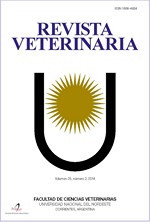Molecular genetic diversity and relationship of indigenous sheep breeds of Pakistan based on nuclear microsatellite loci
DOI:
https://doi.org/10.30972/vet.3013906Palavras-chave:
Sheep, buchi, hashtnagri, genetic diversity, microsatellite markers, PakistánResumo
Sheep genetic resources are high in Pakistan with a number of different breeds spread throughout the country. However, the molecular diversity of sheep breeds is poorly understood in Pakistan. Therefore, in the present study 16 microsatellite markers were used in microsatellite on Buchi and Hashtnagri indigenous breeds of Punjab and Balochistan provinces, respectively. Blood samples from 25 unrelated individuals were collected for genetic diversity and relationship investigation. The mean number of alleles on Buchi and Hashtnagri were 3.375±1.455 and 3.50±1.591, respectively. The mean observed heterozygosity for Buchi was 0.878±0.204 while for Hashtnagri it was 0.885±0.218. The mean Shannon Index showed 1.032±0.371 and 1.070±0.412 for Buchi and Hashtnagri respectively. Inbreeding estimates (FIS and FIT) showed negative values while mean gene flow showed 10.09 and mean population difference (FST) showed 2.4%. According to these results, Buchi and Hashtnagri indigenous breeds showed considerable amount of genetic diversity. There is a decent scope for conservation, effective improvement, and designing suitable breeding strategies for sheep breeds in near future.
Downloads
Downloads
Publicado
Como Citar
Edição
Seção
Licença
Copyright (c) 2019 T Hussain, M M. Musthafa, M E. Babar, M Shaheen, F M. Marikar

Este trabalho está licenciado sob uma licença Creative Commons Attribution-NonCommercial 4.0 International License.
Política de acceso abierto
Esta revista proporciona un acceso abierto inmediato a su contenido, basado en el principio de que ofrecer al público un acceso libre a las investigaciones ayuda a un mayor intercambio global de conocimiento. La publicación por parte de terceros será autorizada por Revista Veterinaria toda vez que se la reconozca debidamente y en forma explícita como lugar de publicación del original.
Esta obra está bajo una licencia de Creative Commons Reconocimiento-NoComercial 4.0 Internacional (CC BY-NC 4.0)










.jpg)
.jpg)



